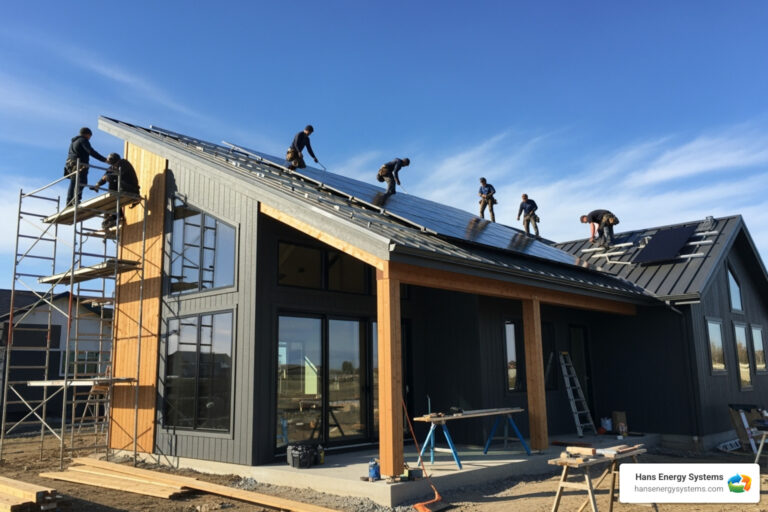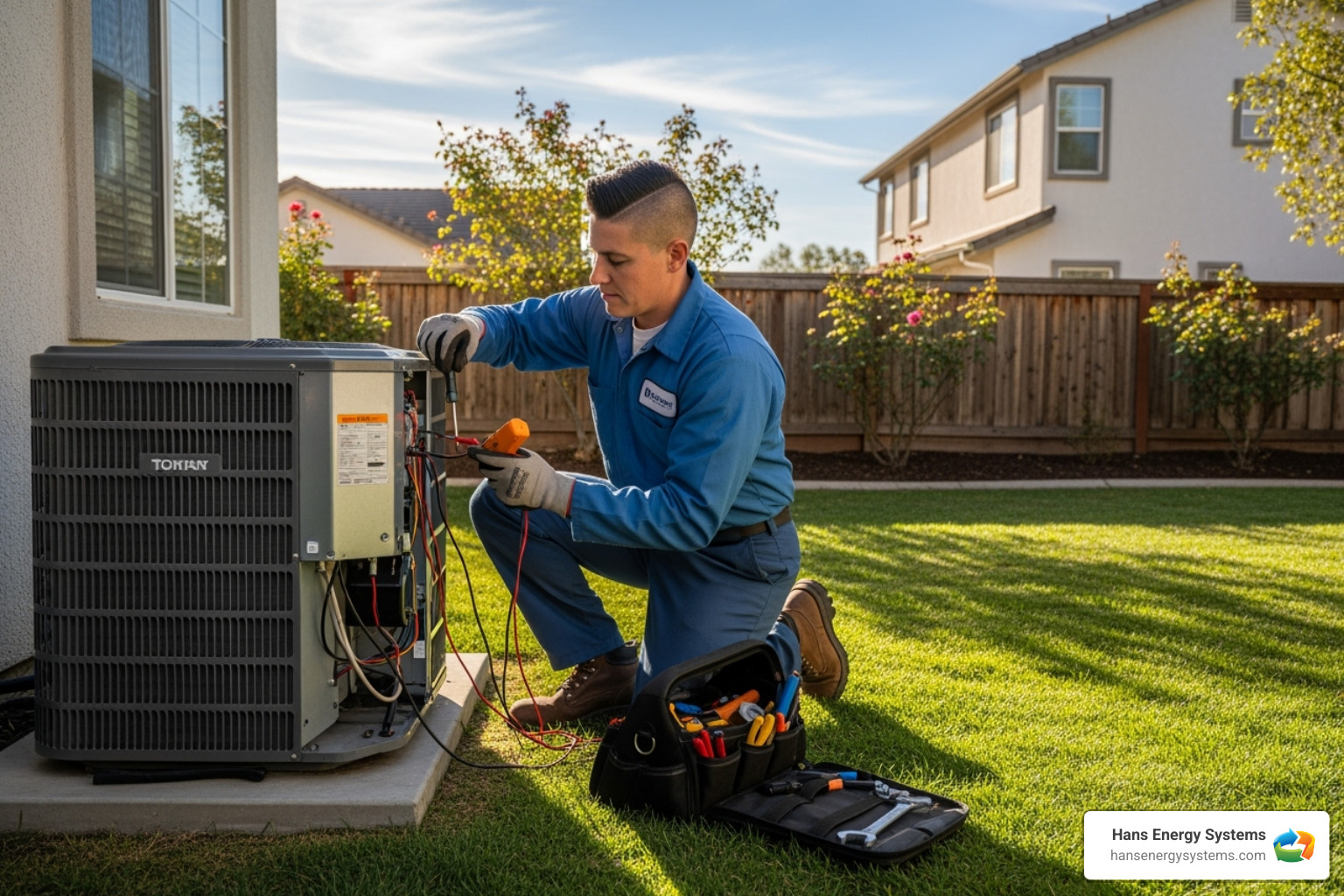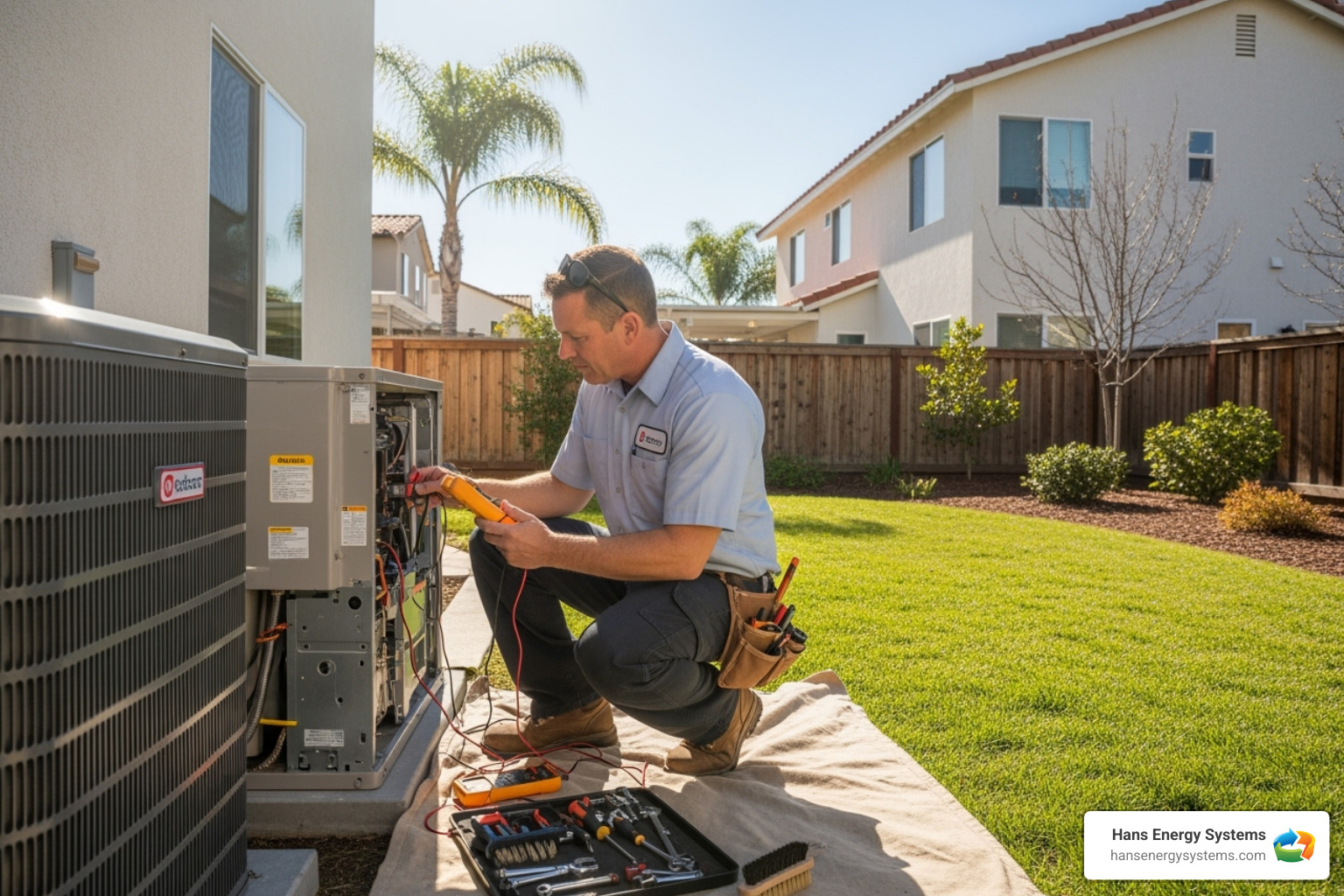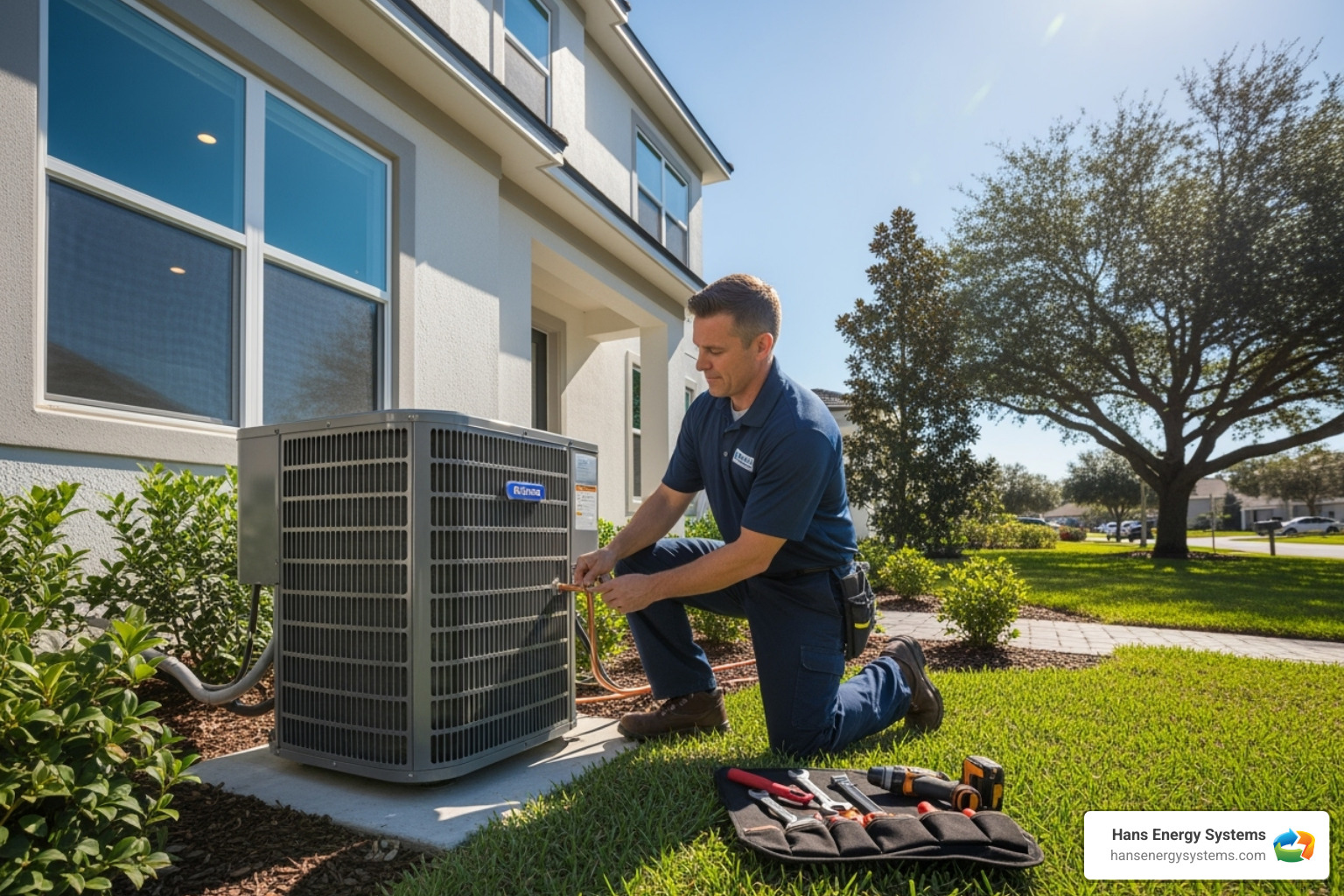Why Solar for New Construction is a Game-Changer
Solar for new construction offers the perfect opportunity to integrate clean energy into your home from the ground up, maximizing both savings and efficiency compared to retrofitting later.
Key benefits of installing solar during new construction:
- Cost savings: Typically 15-20% less expensive than retrofitting
- Seamless integration: Wiring and conduit installed during construction
- Higher home value: Homes with solar sell for tens of thousands more
- Optimal design: Roof orientation and structure planned for maximum solar production
- Financing advantages: Solar costs can be rolled into your mortgage
Building a new home comes with hundreds of decisions, large and small. As one expert noted, “Whether you know it or not, more people are opting to install solar power for new home construction.” The question isn’t whether solar makes sense – it’s whether you can afford not to include it.
The timing couldn’t be better. Solar costs have dropped dramatically over recent years, and with California’s solar mandate for new homes since 2020, the infrastructure and expertise are already in place. When you integrate solar from day one, you avoid the complexity and higher costs of retrofitting later.
The key is planning early. Simple design choices made during construction – like roof orientation, electrical panel sizing, and conduit placement – can save thousands later while maximizing your system’s performance for decades to come.
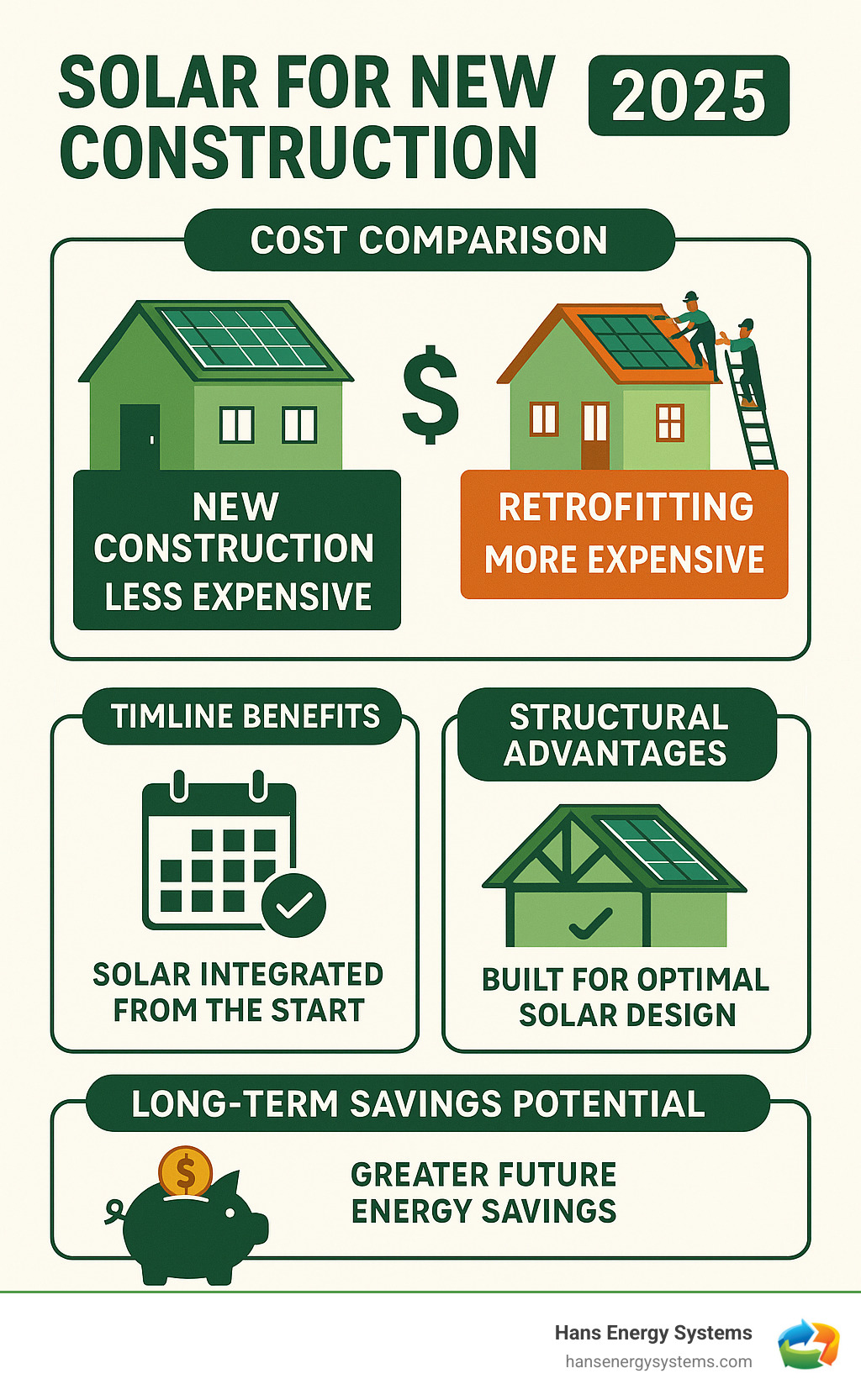
The Unbeatable Benefits of Integrating Solar into New Construction
Picture this: you’re building your dream home, making countless decisions about everything from kitchen countertops to paint colors. But here’s one choice that keeps paying you back long after you’ve moved in. Solar for new construction isn’t just another checkbox on your building list – it’s your ticket to a smarter, more valuable, and environmentally conscious lifestyle.
Boost Your Home’s Value and Slash Energy Bills
Let’s start with everyone’s favorite topic: money in your pocket. When you install solar during construction, you’re essentially buying yourself a raise that lasts for decades. Your monthly electricity bills don’t just shrink – they might disappear entirely during sunny months.
But the financial benefits go way beyond monthly savings. A SETO-funded study revealed something homeowners love to hear: buyers consistently pay more for homes with solar panels. We’re talking about a significant increase in your property value that makes your home more attractive when it’s time to sell.
Think about it this way – while your neighbors are watching their utility bills climb year after year, you’ll be protected from those rising energy costs. This protection translates into substantial long-term ROI that just keeps getting better with time.
The beauty of understanding your solar energy revenue potential is realizing that your roof becomes a mini power plant. Every sunny day, your home is literally making money while you sleep, work, or vacation.
Achieve Energy Independence and a Greener Footprint
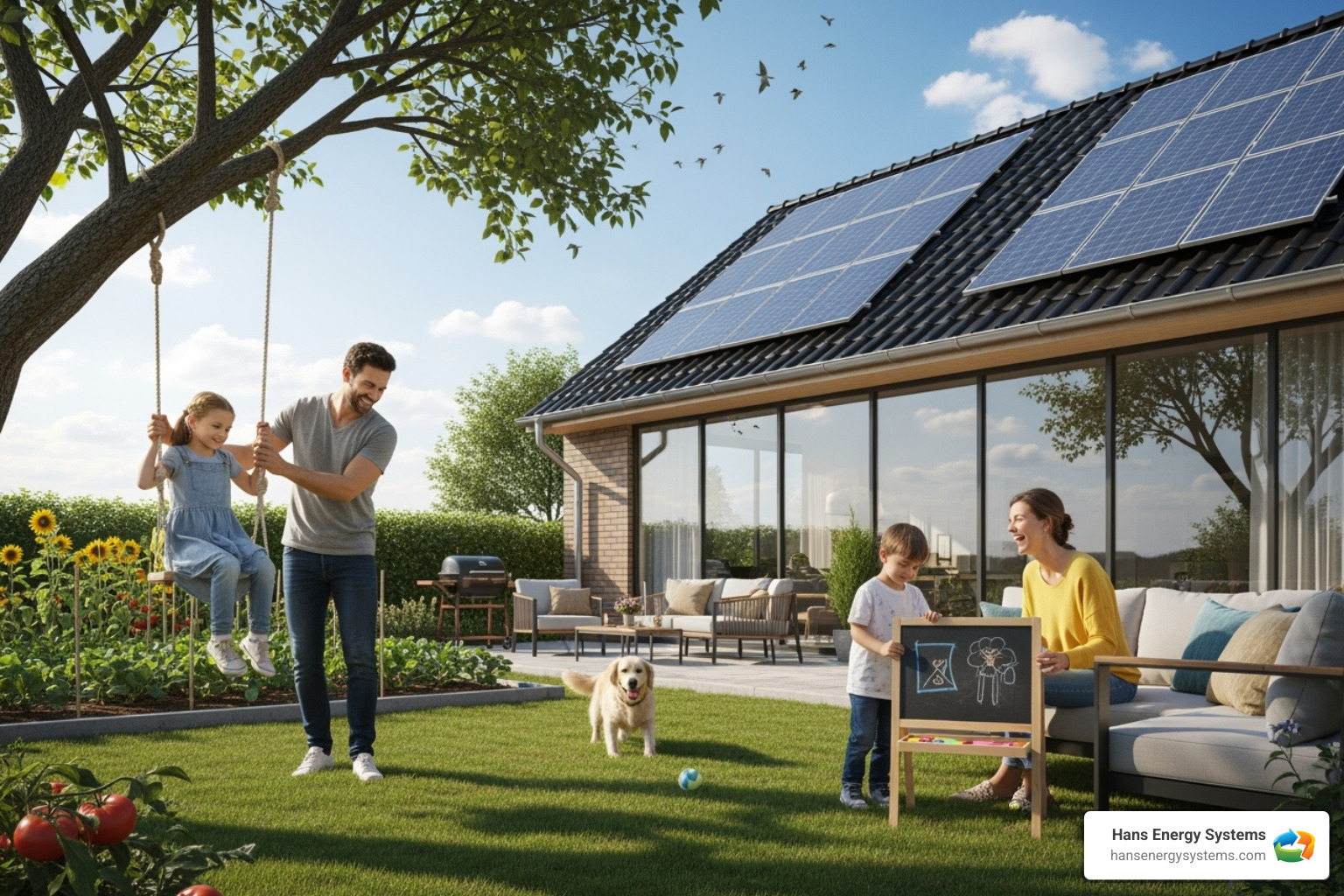
There’s something deeply satisfying about generating your own clean, renewable energy. When the sun rises each morning, you’re not just getting natural light – you’re harvesting power for your home. This energy independence means you’re less tied to the traditional grid and its unpredictable price swings.
But let’s talk about the bigger picture. Every kilowatt your solar panels produce represents a reduced carbon footprint. You’re actively contributing to cleaner air and a healthier planet. The environmental impact of solar extends far beyond your property lines, creating positive change for your entire community.
Here’s a practical benefit that really hits home during emergencies: energy security during grid outages. While your neighbors might be dealing with spoiled food and dead phones during power outages, your solar-powered home can keep running smoothly, especially when paired with battery storage.
You’re not just building a house – you’re contributing to a healthier community by reducing demand on the electrical grid and decreasing pollution. It’s amazing how one smart decision during construction can create ripple effects of positive change for years to come.
Your Blueprint for a Solar-Ready Home: Design & Planning
When you’re building a new home, you have a golden opportunity that retrofit homeowners can only dream of – the chance to design your space specifically for solar success. Think of solar for new construction as weaving sunshine into your home’s DNA from the very beginning.
A truly solar-ready home isn’t built by accident. It requires thoughtful planning that considers everything from roof angles to electrical pathways. The beauty is that these smart choices made during construction will pay dividends for decades to come.
Key Architectural and Design Considerations
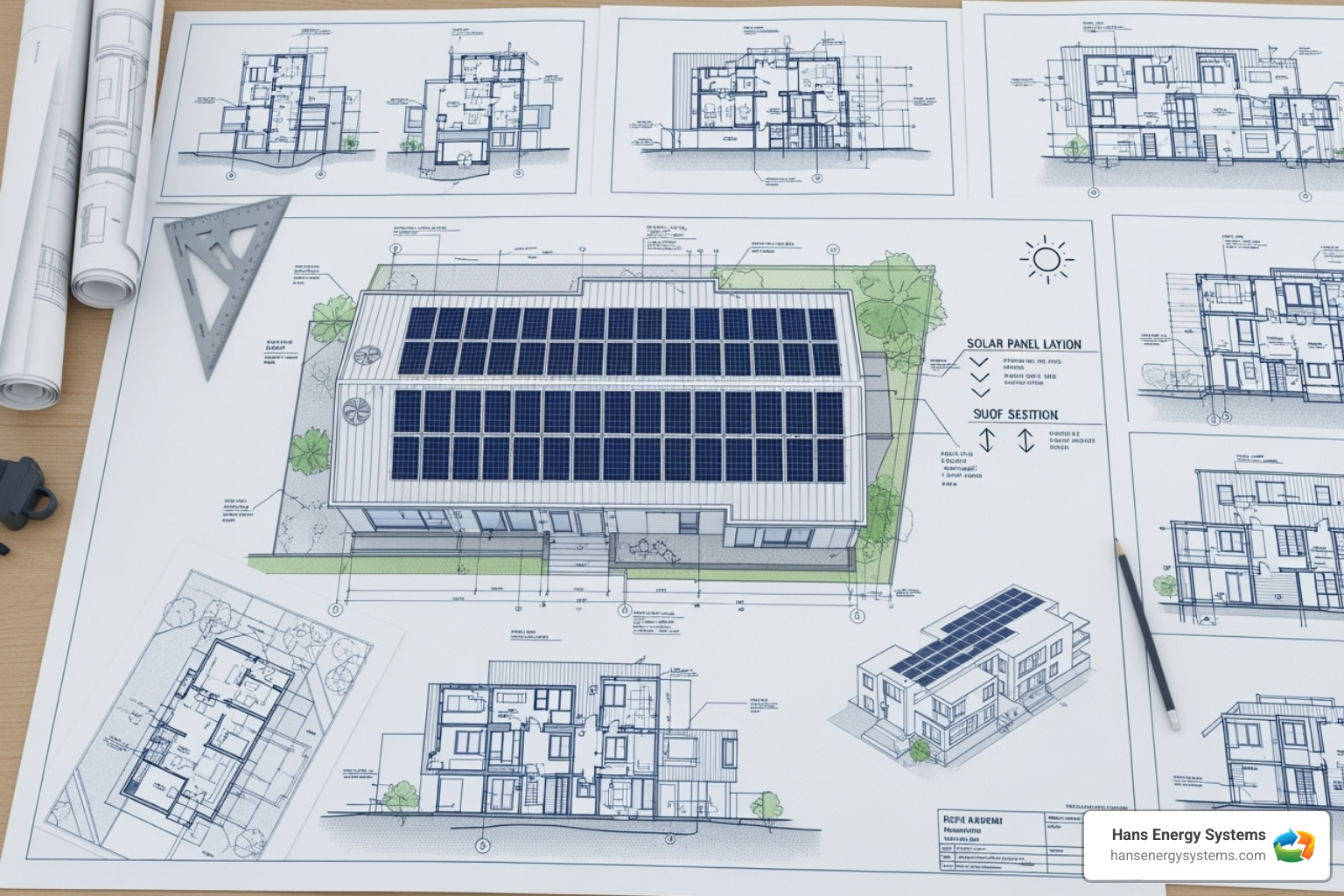
The sun has its favorites when it comes to roof real estate. South-facing roofs are the gold standard, but don’t worry if your lot doesn’t allow for perfect southern exposure. East and west-facing sections can still perform beautifully, capturing those gorgeous morning and afternoon rays.
Roof pitch matters too. The sweet spot falls between 15 and 40 degrees – steep enough to shed rain and snow, but not so steep that installation becomes a circus act. These design considerations from the National Association of Home Builders provide excellent guidance for builders and homeowners alike.
Your roof needs to be strong enough to handle the additional weight of solar panels and their mounting systems. This structural support consideration is much easier to address during construction than trying to reinforce later. We also focus on minimizing shade from architectural features like chimneys, vents, and dormers. Even a small shadow can significantly impact your system’s performance, and understanding how shade affects your solar panel output helps us design around potential obstacles.
Here’s where the real magic happens: pre-installing conduit and wiring during construction. Running electrical pathways from your main panel to the roof while the walls are still open saves tremendous time, money, and headaches later. It’s like building hidden highways for your solar energy to travel on.
Integrating Battery Storage and EV Charging from Day One
Imagine your solar panels as a personal power plant and battery storage as your energy savings account. Home battery systems store the excess energy your panels produce during sunny days, letting you use that power when the sun goes down or during grid outages.
The benefits of energy storage go far beyond just keeping the lights on during blackouts. You get an uninterrupted power supply that gives you true energy independence. You’re also maximizing self-consumption – using more of your own clean power instead of buying expensive electricity from the utility company during peak hours.
We encourage homeowners to start exploring battery storage for solar energy early in their planning process. The integration is seamless when planned from the beginning.
And let’s talk about the future of transportation. Preparing for an electric vehicle during construction means installing the proper wiring and charging infrastructure alongside your solar system. Picture this: your car running on pure sunshine. It’s not science fiction – it’s happening right now, and you can learn more about charging your EV with solar panels to see how beautifully these technologies work together.
Navigating Local Building Codes and Regulations
Nobody builds a house without permits, and solar installations are no different. The good news? California’s solar mandate has made the process much smoother for new construction. Since 2020, all new homes in California must include solar, which means builders and local authorities are well-versed in the requirements.
For our friends in Poway, the city provides clear guidance through their Solar PV permit info resources. We handle the complexities of utility interconnection agreements – the paperwork that allows your system to connect with the electrical grid safely and legally.
Working with your builder is crucial for success. The best outcomes happen when your solar installer coordinates closely with your construction team from the early stages. This collaboration ensures that electrical work, structural considerations, and installation timing all align perfectly.
Ensuring compliance with local codes isn’t just about checking boxes – it’s about safety, performance, and protecting your investment. When everything is done right from the start, your solar system will operate efficiently and safely for decades to come.
The Financial Side: Costs and Incentives for Solar for New Construction
When you’re planning a new home, every dollar counts. The good news? Solar for new construction isn’t just an environmentally conscious choice – it’s a financially smart one that can save you thousands compared to waiting.
New Build vs. Retrofit: A Cost Comparison for Solar for New Construction
Here’s something that might surprise you: installing solar during construction costs significantly less than adding it later. Industry experts consistently find that homeowners can expect substantial savings when they choose solar from day one rather than retrofitting.
Why such a dramatic difference? It all comes down to efficiency and timing. When you’re already building, the electricians are there, the roof work is happening, and the permits are being processed. Your solar installation becomes part of the natural workflow instead of a separate, disruptive project.
| Feature | New Build Solar Installation | Retrofit Solar Installation |
|---|---|---|
| Cost Efficiency | Lower labor costs due to integrated work, bundled electrical. | Higher labor costs for separate site visits, specialized work. |
| Electrical Work | Conduit and panel upgrades part of original electrical plan. | Requires separate electrical work, potential panel upgrades. |
| Roof Integrity | Integrated into roof design, no post-construction penetrations. | Potential for roof penetrations, affecting roof warranty. |
| Design Freedom | Optimal roof orientation and shading avoidance from day one. | Limited by existing roof structure and surrounding obstacles. |
| Permitting | Often bundled with home construction permits. | Requires separate solar-specific permits and inspections. |
| Overall Savings | Homeowners can expect to save about $1000 or more. | Can incur additional costs for structural or electrical modifications. |
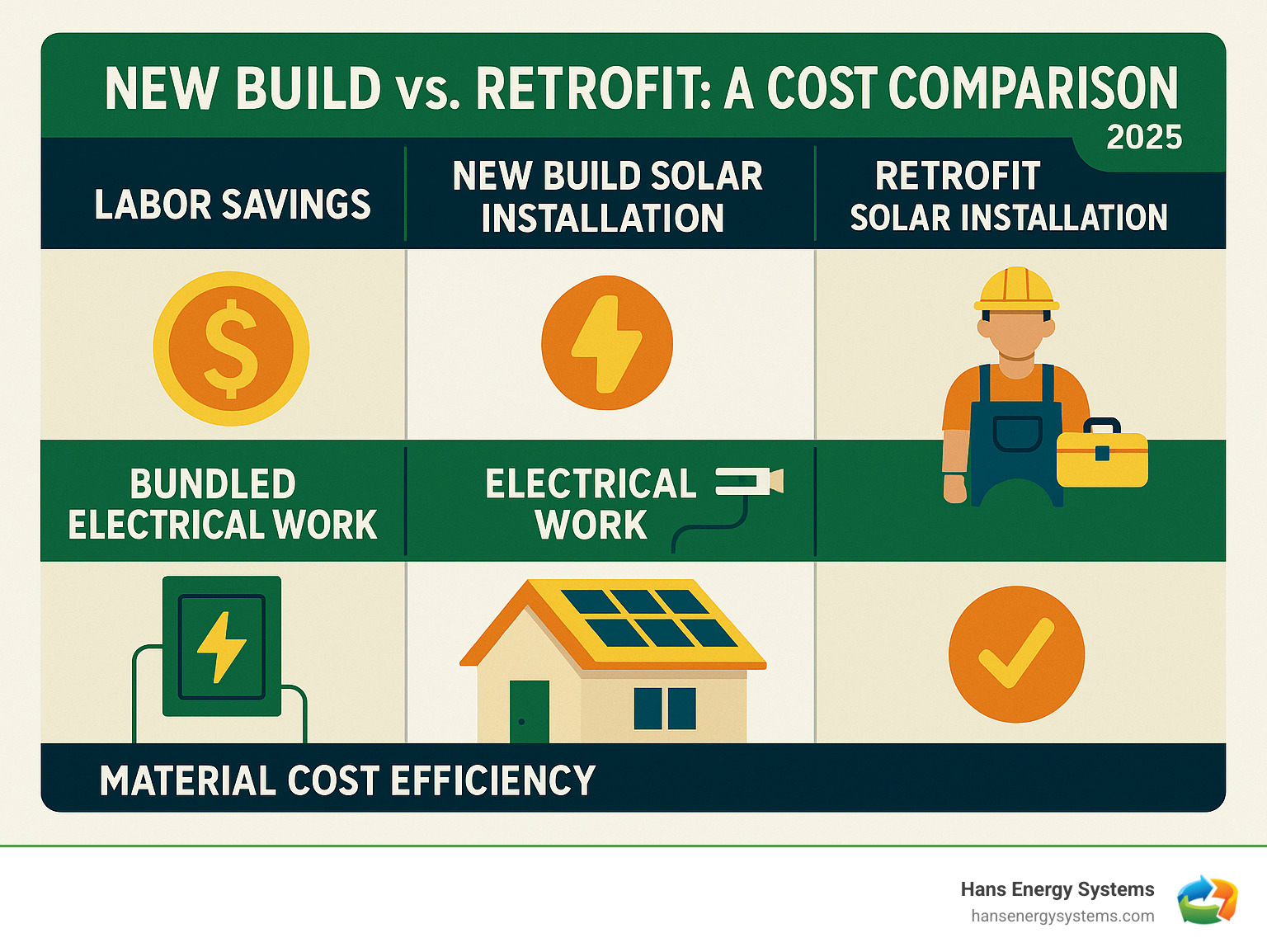
The labor savings alone make a compelling case. Instead of separate crews coming to your finished home, everything happens in coordination. Your electrical work gets bundled into the overall construction plan, and there’s no need for future roof modifications that could affect your warranty.
Material costs also work in your favor during new construction. Bulk purchasing power and streamlined logistics mean better pricing on everything from panels to inverters. Plus, you avoid the premium costs that come with retrofitting – no need for specialized equipment to work around existing structures or multiple site visits.
Financing Your System and Opening Up Tax Incentives
One of the biggest advantages of solar for new construction is how you can pay for it. Instead of taking out a separate solar loan with higher monthly payments, you can roll the solar costs directly into your home mortgage. This transforms what could be a significant monthly expense into a small addition to your long-term mortgage payment.
Think about it this way: a separate solar loan might require substantial monthly payments over just a few years. But when solar becomes part of your mortgage, those same costs get spread over decades, making your monthly impact much more manageable. You’re essentially financing your solar system at mortgage rates rather than higher loan rates.
The Federal Solar Tax Credit (ITC) sweetens the deal even further. This credit allows you to reduce your federal tax liability based on your solar installation costs. It’s like getting a substantial rebate for choosing clean energy – money that goes right back into your pocket.
Don’t forget about state and local incentives either. Many areas offer additional rebates and programs that can further reduce your investment. The Database of State Incentives for Renewables & Efficiency is a great resource to explore what’s available in your specific location.
For homeowners in our service area, we make financing even easier with comprehensive financing options in Poway, CA designed to fit different budgets and preferences. Our goal is making solar accessible, not just during construction, but for your long-term financial comfort.
The bottom line? Solar for new construction isn’t just about doing the right thing for the environment – it’s about making a smart financial decision that pays dividends for decades to come.
The Installation Process: A Guide for Homeowners and Builders
When you’re building a new home, adding solar feels like orchestrating a carefully planned dance. Every step needs perfect timing, and that’s exactly what makes solar for new construction so much smoother than trying to add it later. Think of it this way: you’re already bringing in electricians, roofers, and contractors – why not have them all work together from the start?
Choosing the Right Solar Installer for Your New Build
Finding the right solar installer for your new build isn’t just about finding someone who knows solar panels. You need a team that speaks “construction site” fluently and can work seamlessly with your builder’s timeline. It’s like finding a contractor who can waltz with your electrician and tango with your roofer.
Experience with new construction is absolutely essential. A seasoned installer knows when to show up during the building process, how to coordinate with other trades without stepping on anyone’s toes, and most importantly, how to integrate solar into your home’s design so it looks like it was always meant to be there.
Verifying certifications should be at the top of your checklist. The North American Board of Certified Energy Practitioners (NABCEP) certification is the gold standard in our industry. It’s like a diploma that proves your installer has the knowledge and skills to do the job safely and effectively. Construction professionals without proper solar certification simply shouldn’t be touching your solar installation.
Don’t forget to check licenses and insurance – it protects both you and your investment. And always read customer reviews, especially from other homeowners who’ve done new construction solar projects. Their experiences can give you valuable insights into how well an installer communicates and delivers on their promises.
Here at Hans Energy Systems, we’ve built our reputation on seamless new construction solar projects throughout San Diego County. We’d love to discuss your project and provide you with competitive quotes that fit your timeline and budget.
A Step-by-Step Guide to the Solar for New Construction Process
The beauty of solar for new construction lies in its logical flow. When everything is planned from the beginning, each step builds naturally on the last one.
Early coordination with your builder is where the magic begins. The moment you decide on solar, bring us into the conversation with your home builder. We’ll review blueprints together, discuss the best roof orientation for maximum sun exposure, and plan out structural requirements and electrical pathways. Starting early saves everyone headaches later.
Customized system design and engineering comes next. Our team analyzes your home’s plans, your family’s energy needs, and your property’s sun exposure patterns to create a system that’s perfectly custom to your situation. We use advanced tools to estimate energy production and ensure your system will meet your goals. Our customized design of photovoltaic systems to offset electrical bill approach means no cookie-cutter solutions – just what works best for your home.
While you’re picking out paint colors and cabinet hardware, we’re handling permitting and approvals. This includes local building permits and utility interconnection agreements. It’s paperwork that needs doing, but you shouldn’t have to worry about it.
The rough-in phase is where the real coordination happens. During the early construction stages, our team works alongside your builder to install the necessary conduit and wiring within the walls and roof structure. This is the behind-the-scenes work that makes the final installation look effortless and clean.
Panel and equipment installation happens once your roof is ready. Because all the rough-in work is already complete, installing the actual solar panels and equipment like inverters and batteries is surprisingly quick. It’s like having all the plumbing roughed in before installing the fixtures – everything just clicks into place.
Before your system can start generating power, it goes through final inspections by local authorities and the utility company. These ensure everything meets safety and operational standards. It might seem like red tape, but these inspections protect you and your investment.
Finally comes grid connection and commissioning – the moment your solar system comes to life. We connect everything to the grid, test all the systems, and then teach you how to monitor your new home power plant. There’s something pretty satisfying about watching those first kilowatts start flowing from your roof to your home.
Frequently Asked Questions about Solar for New Homes
We get it – adding solar to your new home build brings up a lot of questions. After years of helping families steer solar for new construction, we’ve heard just about everything. Here are the most common concerns we address, along with honest answers that’ll put your mind at ease.
What happens if my builder has never installed solar before?
This happens more often than you’d think, and honestly, it’s not a problem at all! Your builder doesn’t need to be a solar expert – that’s our job. What matters is good communication between all the teams involved.
Here’s how it works: A qualified solar installer like us handles all the solar-specific work – the design, permitting, and actual installation of panels and equipment. Your builder focuses on what they do best: building your home and preparing the site according to our detailed specifications.
We provide your builder with everything they need to know about roof loading requirements, where to run electrical conduit, and how to prepare for our installation. It’s actually quite seamless when everyone stays in touch throughout the process. Think of it as a well-orchestrated team effort where each expert handles their specialty.
Can I still get solar if my roof isn’t perfectly south-facing?
Absolutely! While south-facing roofs are the gold standard for solar production, they’re far from the only option that makes financial sense.
East and west-facing roofs can still be incredibly effective. East-facing panels capture that beautiful morning sun, while west-facing panels soak up the afternoon rays. You’re typically looking at about 80% of the energy production compared to a perfect south-facing setup – which is still excellent for most homes.
The key is working with a professional installer who understands how to design a system for your specific situation. We take into account your roof’s angle, orientation, and any potential shading throughout the year. Our expertise in finding the best solar panel placement for sun exposure means we can maximize your system’s performance regardless of which direction your roof faces.
How long do solar panels last and what maintenance is required?
This is one of the best parts about solar for new construction – you’re investing in technology that’s built to last decades with minimal fuss.
Most quality solar panels come with 25-year performance warranties, and many continue producing clean energy well beyond that timeframe. We’re talking about panels that’ll still generate at least 80% of their original power output after a quarter-century. They’re engineered to handle everything Mother Nature throws at them – hail, high winds, temperature swings, you name it.
As for maintenance, it’s refreshingly simple. Since there are no moving parts to break down or wear out, your main concern is keeping the panels reasonably clean. Dust, pollen, and bird droppings can reduce efficiency if they build up over time, but regular rain handles most of this naturally.
For times when you need a deeper clean, we offer professional solar panel cleaning and maintenance services. We can also help you understand when solar panels need professional cleaning to keep your investment performing at its peak for years to come.
Conclusion: Build a Smarter, More Sustainable Future
When you step back and look at everything we’ve covered, one thing becomes crystal clear: solar for new construction isn’t just about adding panels to your roof. It’s about making a choice that ripples through every aspect of your homeownership experience for decades to come.
Think about it – you’re already making the biggest investment of your life. Why not make it work even harder for you? The increased property value alone makes solar a no-brainer, but when you add in those significant long-term energy savings and the peace of mind that comes with energy independence, you’re not just building a house. You’re crafting a lifestyle that’s both financially smart and environmentally responsible.
The environmental impact might feel abstract now, but every kilowatt-hour your panels generate is a small victory for our planet. And honestly, there’s something pretty satisfying about watching your electric meter spin backwards on a sunny day, knowing you’re contributing to a healthier community while your neighbors are still tied to rising energy costs.
Here’s what we can’t stress enough: the importance of planning early in the construction process cannot be overstated. Once that roof is on and those walls are closed up, your options become limited and expensive. But right now, in this planning phase, you have the golden opportunity to integrate everything seamlessly – from optimal roof orientation to pre-installed conduit that makes the whole process smooth as butter.
For homeowners in San Diego County, you don’t have to steer this journey alone. Partnering with an experienced local expert like Hans Energy Systems means you get someone who understands both the technical side of solar and the practical realities of working with builders. We’ve been through this process countless times, and we know exactly how to coordinate with your construction team to make everything flow perfectly.
The bottom line? Don’t miss this chance to build a smarter, more sustainable home from the ground up. Your future self – and your wallet – will thank you for making the smart choice today. Ready to get started? We’re here to help you start your solar journey with a professional solar panel installation in Poway, CA.


